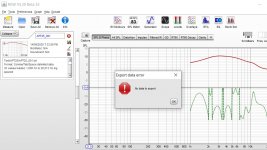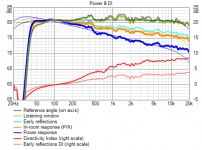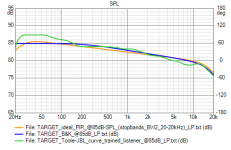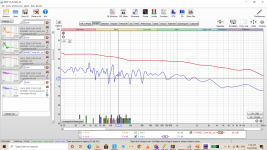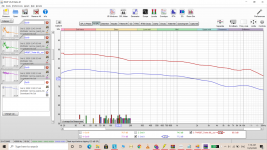Be aware myself havent any 2x4HD so had to look up the manual at miniDSP site and cant see any big mistake other than notice there is a total of 4096 taps awailable distributed over 4 output channels but no output channel must be set with a number lower than 6 tabs, and the number of taps shall be entered in the lower right corner dialog named "Tabs used:", so will ask have you entered the 2000 tabs number you use there in that lower right corner for one or 2 channels with that dot.bin-file and set the other two or three channels to a number not less than 6.. hope it can help else suggest try lookup some miniDSP user forum for unit.
yes 4096 for 4 channels, i can distribute them as i please, with a minimum of 6 taps and a max of 2042 approximatly, so i'm using that as instructed
I am I just tried it and it says no data to export, have you tried it?
Once you got your frequency domain (phase+magnitude),its a transform (FFT) of the impulse.
Take a look at the export tab.
Have you actually tried to do it? Import a frequency response, select export Impulse response as wav, you get no data to export.
If you import a frequency response there is no data in the impulse tab or anything that is derived from the impulse tab and as far as I know no way to get REW to generate it.
I understand that it can be done but REW doesn't have a function to do it that I can find. I am happy to be proved wrong if you can show me how you have done it.
BTW Kessito wanted the function in rephase for it's ability to optimize the filter at lower tap counts. VituixCAD itself can export the IR directly.
If you import a frequency response there is no data in the impulse tab or anything that is derived from the impulse tab and as far as I know no way to get REW to generate it.
I understand that it can be done but REW doesn't have a function to do it that I can find. I am happy to be proved wrong if you can show me how you have done it.
BTW Kessito wanted the function in rephase for it's ability to optimize the filter at lower tap counts. VituixCAD itself can export the IR directly.
Last edited:
Be aware myself havent any 2x4HD so had to look up the manual at miniDSP site and cant see any big mistake other than notice there is a total of 4096 taps awailable distributed over 4 output channels but no output channel must be set with a number lower than 6 tabs, and the number of taps shall be entered in the lower right corner dialog named "Tabs used:", so will ask have you entered the 2000 tabs number you use there in that lower right corner for one or 2 channels with that dot.bin-file and set the other two or three channels to a number not less than 6.. hope it can help else suggest try lookup some miniDSP user forum for unit.
yes 4096 for 4 channels, i can distribute them as i please, with a minimum of 6 taps and a max of 2042 approximatly, so i'm using that as instructed
This is my last post on this as anyone can come to their own conclusion by actually trying it. I am using Beta 53, the option is there in the menu but it does not work when you try to use it based on a frequency and phase response only.
Load one up and press the button you will get the same error.
Load one up and press the button you will get the same error.
Attachments
Hey guys, i'm really stuck here and need some help.
I bought a minidsp 2x4HD and a CSL calibrated UMIK-1, I recently discovered that Minidsp 2x4HD have FIR filters that i can use, searched for tutorials on how to use Rephase with REW to make the filters
-i start by taking 9 measurements for each speaker.
-i time allign them and vector average them.
-i EQ simulate the response and save the filters.
-i export the vectored response as a text and import it into rephase.
-i import the filters into rephase.
-I then generate lpcm 32 bit Mono impulse response and import it into REW
-using the trace arithmic i multiply the vector response to the impulse reponse(A*B), and generate an excess phase to the corrected response
-i export the excess phase as txt to rephase and fix the phase using filter linearization and paragrephic phase EQ till it s closest to 0 degree from 100 to 20 khz , i import the vectored response and apply the filters again.
-i generate the response to use in minidsp2x4 HD using the allowed 2048 tap and using the bin. format, makig sure that the response in rephase is still good due to the low number of taps.
-i upload the taps into the minidsp and try measuring again, the frequency response is way worse and the phase and impulse aswell.
i ve tried using the IIR filters in minidsp to flatten out the response and using the FIR filters to fix the phase, whatever i try to phase is still very bad after trying to fix it in rephase.
any tips of what i'm doing wrong is appreciated
Hi zallou3,
everything makes sense to me until this step...
-I then generate lpcm 32 bit Mono impulse response and import it into REW
i don't understand why you would import the lpcm 32 bit into REW for further work.
I would simply load that FIR file into the 2x4HD, and measure the speaker.
All the steps that followed seem unnecessary and overcomplicated.
I must be missing something as to why you would take them.....
What I would do, is after measurement and filter import into rephase from REW, use further manual PEQ's and phase linearization's to get best predicted response, along with linear phase xover.
Then generate the FIR file...(and stick it straight into 2x4HD)
Like fluid said, it's probably best to skip trying to correct averaged measurements, especially with regard to phase, until you have the workflow and logic down pat.
Only other advice fwiw, is Parametric Phase EQ is best avoided.
Out of band minimum phase EQ, and Filter's Linearization are better tools ime.
This is my last post on this as anyone can come to their own conclusion by actually trying it. I am using Beta 53, the option is there in the menu but it does not work when you try to use it based on a frequency and phase response only.
Load one up and press the button you will get the same error.
Hi fluid, REW has never been able to import a frequency response file (mag and phase only) and then export an impulse, afaik.
As it can't even generate an impulse response for display from the imported mag and phase file...
REW needs an impulse import to be able to fully function using external measurements ime.
It's one of the things that is maddening working back and forth with Smaart and REW.....
Smaart doesn't automatically save an impulse file, so i can't really look in depth at Smaart's transfer function files imported into in REW.
i don't understand why you would import the lpcm 32 bit into REW for further work.
Only other advice fwiw, is Parametric Phase EQ is best avoided.
Out of band minimum phase EQ, and Filter's Linearization are better tools ime.
The reason to import it back it is to generate the excess phase version for correction based on the vector averaged measurement. To do that by loading the FIR filter would mean another 9 measurements.
As I said I don't think it is the most successful way to do it but it makes sense if that is what you are trying to do.
I would also agree with the sentiments in the second half of the quote except that phase EQ if used carefully and sparingly can be quite useful with non minimum phase issues in the lowest frequencies. Very easy to get wrong and make things worse but it can help sometimes if a physical acoustic fix is not possible.
Hi zallou3,
everything makes sense to me until this step...
-I then generate lpcm 32 bit Mono impulse response and import it into REW
i don't understand why you would import the lpcm 32 bit into REW for further work.
I would simply load that FIR file into the 2x4HD, and measure the speaker.
All the steps that followed seem unnecessary and overcomplicated.
I must be missing something as to why you would take them.....
What I would do, is after measurement and filter import into rephase from REW, use further manual PEQ's and phase linearization's to get best predicted response, along with linear phase xover.
Then generate the FIR file...(and stick it straight into 2x4HD)
Like fluid said, it's probably best to skip trying to correct averaged measurements, especially with regard to phase, until you have the workflow and logic down pat.
Only other advice fwiw, is Parametric Phase EQ is best avoided.
Out of band minimum phase EQ, and Filter's Linearization are better tools ime.
just like @fluid said, to generate the excess phase , i did make some improvements though i would say, i lasered the distance between the speakers and the LP
set the mic right in the middle and took 1 left and right measurement, applied PEQ and fixed the phase with Rephase, below are the attached pictures (brown with the FIR fitlers cyan without)
Attachments
-
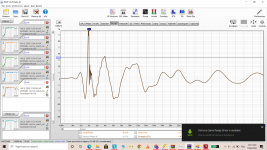 Screenshot (93).png527 KB · Views: 63
Screenshot (93).png527 KB · Views: 63 -
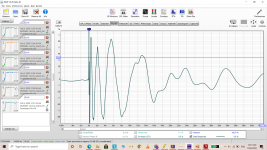 Screenshot (92).png557.8 KB · Views: 45
Screenshot (92).png557.8 KB · Views: 45 -
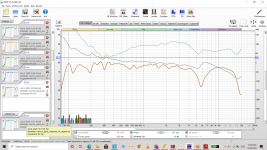 Screenshot (86).png597.6 KB · Views: 52
Screenshot (86).png597.6 KB · Views: 52 -
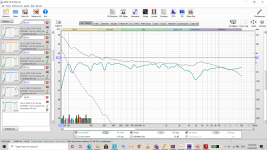 Screenshot (87).png561.4 KB · Views: 59
Screenshot (87).png561.4 KB · Views: 59 -
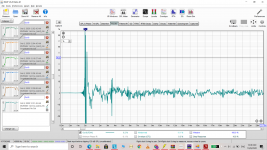 Screenshot (88).png575.9 KB · Views: 51
Screenshot (88).png575.9 KB · Views: 51 -
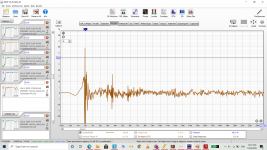 Screenshot (89).png577.3 KB · Views: 95
Screenshot (89).png577.3 KB · Views: 95 -
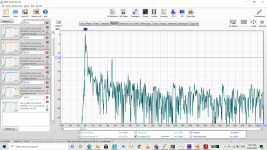 Screenshot (90).png667.6 KB · Views: 103
Screenshot (90).png667.6 KB · Views: 103 -
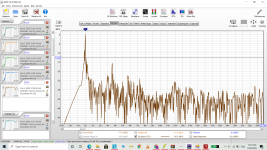 Screenshot (91).png676.8 KB · Views: 107
Screenshot (91).png676.8 KB · Views: 107
would appreciate your opinion and tips on the pics i just uploaded in the other reply, tell me what you think pleaseThe reason to import it back it is to generate the excess phase version for correction based on the vector averaged measurement. To do that by loading the FIR filter would mean another 9 measurements.
As I said I don't think it is the most successful way to do it but it makes sense if that is what you are trying to do.
I would also agree with the sentiments in the second half of the quote except that phase EQ if used carefully and sparingly can be quite useful with non minimum phase issues in the lowest frequencies. Very easy to get wrong and make things worse but it can help sometimes if a physical acoustic fix is not possible.
The reason to import it back it is to generate the excess phase version for correction based on the vector averaged measurement. To do that by loading the FIR filter would mean another 9 measurements.
As I said I don't think it is the most successful way to do it but it makes sense if that is what you are trying to do.
I would also agree with the sentiments in the second half of the quote except that phase EQ if used carefully and sparingly can be quite useful with non minimum phase issues in the lowest frequencies. Very easy to get wrong and make things worse but it can help sometimes if a physical acoustic fix is not possible.
Hi fluid, Why not just correct the vector averaged measurement, both mag and phase phase, as it stands? Why any further work?
Personally, i've come to believe the only valid phase corrections for drivers are minimum phase.
So parametric phase EQ alone (without accompanying min phase mag correction) seems bogus to me.
And also think the only non-problematic xovers are linear phase.
would appreciate your opinion and tips on the pics i just uploaded in the other reply, tell me what you think please
I don't see much difference between them other than a different impulse shape and more movement before the peak from the phase correction in the FIR.
My thoughts would be the same as before, leave the phase alone until you have got the basic PEQ where you want it. The only excess phase left after the first PEQ correction comes from the crossovers or non minimum phase room effects that are in the measurements. Trying to fiddle with these things should be the very last step in the process if you do it at all.
Getting the right tonal balance is probably the most important aspect to making a speaker sound good. Personal taste is a big factor too.
If you can post a link to your mdat from google drive or something like that I can have a look at the measurements for you. The one with the individual measurements used to make the vector average.
The why is because zallou3 is following a tutorial where that is a step that is includedHi fluid, Why not just correct the vector averaged measurement, both mag and phase phase, as it stands? Why any further work?
For most conventional speakers I don't disagree with you. My comment above for the use of Phase EQ was related to dealing with room problems. Nothing to do with correcting drivers or speakers.Personally, i've come to believe the only valid phase corrections for drivers are minimum phase.
So parametric phase EQ alone (without accompanying min phase mag correction) seems bogus to me.
And also think the only non-problematic xovers are linear phase.
The why is because zallou3 is following a tutorial where that is a step that is includedIt is also geared towards an existing speaker where the crossover is already in place and someone is trying to "correct" it. I'm not saying it is the best approach to take but it is a simple way to see the excess phase that is left over after the first round of correction.
Sorry for missing that a tutorial was in play....i knew i had to be missing something.
Another fwiw, and just my own view, but i'm getting convinced that using FIR to correct xovers already in place is what's often giving FIR a lackluster reputation.
would be great thanks!
Google Drive: Sign-in
i used a laser meter to make sure the microphone is at the same distance from both speakers, sitting in an equilateral triangle at 190 cms.
my speakers are 4 ways dipoles(only the tweeters are dipoles) they're infinity kappa 8A if that matters.
i'm sitting in a room dedicated for music, nothing between the speakers,next to them or behind them,and in between me and the speakers. first reflections on the side walls,front wall, ceiling and floor have been treated using rockwool panels. they're 70 cms away from the side walls and front walls(wall facing me)
again, not sure if all of this matters but i figured it should cause the speakers are interfering with each other causing cancellations at the LP, each mm to the left or right causes and big dip in the frequency spectrum(you can see it in the shared mdat.)
i took 9 measurements for the left speaker, 9 for the right speaker, and 9 for both of them combined, moving the microphone a few mms to the left and right on each measurement.
no FIR filters, only IIR fiilters loaded into the minidsp for a flatter response.
i drop 2 to 3 db from 1khz to 18 khz to reduce the harshness and brightness of the recordings.
the goal for me is to reproduce the most accurate representation of music in my room. not colored bass heavy music.
you mentioned before my response would sound bright if left flat, what are you recommendations when it comes to frequency responses?
thanks for all your help, much appreciated!
Google Drive: Sign-in
i used a laser meter to make sure the microphone is at the same distance from both speakers, sitting in an equilateral triangle at 190 cms.
my speakers are 4 ways dipoles(only the tweeters are dipoles) they're infinity kappa 8A if that matters.
i'm sitting in a room dedicated for music, nothing between the speakers,next to them or behind them,and in between me and the speakers. first reflections on the side walls,front wall, ceiling and floor have been treated using rockwool panels. they're 70 cms away from the side walls and front walls(wall facing me)
again, not sure if all of this matters but i figured it should cause the speakers are interfering with each other causing cancellations at the LP, each mm to the left or right causes and big dip in the frequency spectrum(you can see it in the shared mdat.)
i took 9 measurements for the left speaker, 9 for the right speaker, and 9 for both of them combined, moving the microphone a few mms to the left and right on each measurement.
no FIR filters, only IIR fiilters loaded into the minidsp for a flatter response.
i drop 2 to 3 db from 1khz to 18 khz to reduce the harshness and brightness of the recordings.
the goal for me is to reproduce the most accurate representation of music in my room. not colored bass heavy music.
you mentioned before my response would sound bright if left flat, what are you recommendations when it comes to frequency responses?
thanks for all your help, much appreciated!
@zallou3,
Have attached three alright target curves in below zip-folder to play around with, within their tonality sceme one should come a long way but of couse adjust for tiny other taste or system deviations, they are what is called "in room response" at listening position or "estimated room response" or "PIR (predicted in room response)" and typical with that curve dialed in at listening position then speaker system if it was measured in anechoic condition or close nearfield will show a flat curve, they hover around 85dB SPL area normalize/offset them your self into REW to whatever SPL..
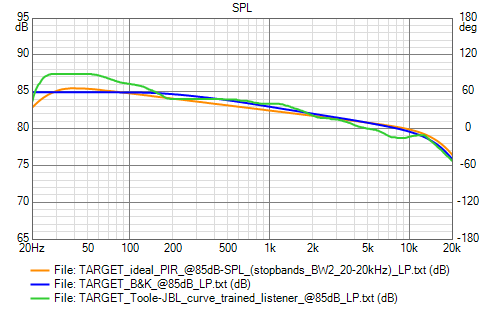
Here is example of a good Genelec performer 8341A measured anechoic over at ASR site, note how the PIR curve follows close to one of the above targets..
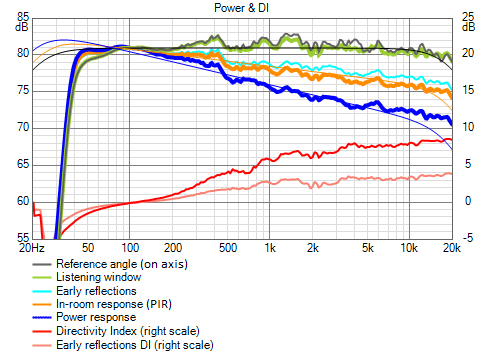
Have attached three alright target curves in below zip-folder to play around with, within their tonality sceme one should come a long way but of couse adjust for tiny other taste or system deviations, they are what is called "in room response" at listening position or "estimated room response" or "PIR (predicted in room response)" and typical with that curve dialed in at listening position then speaker system if it was measured in anechoic condition or close nearfield will show a flat curve, they hover around 85dB SPL area normalize/offset them your self into REW to whatever SPL..
Here is example of a good Genelec performer 8341A measured anechoic over at ASR site, note how the PIR curve follows close to one of the above targets..
Attachments
Last edited:
This is VERY interesting. Thank you for sharing.@zallou3,
Have attached three alright target curves in below zip-folder to play around with, within their tonality sceme one should come a long way but of couse adjust for tiny other taste or system deviations, they are what is called "in room response" at listening position or "estimated room response" or "PIR (predicted in room response)" and typical with that curve dialed in at listening position then speaker system if it was measured in anechoic condition or close nearfield will show a flat curve, they hover around 85dB SPL area normalize/offset them your self into REW to whatever SPL..
Here is example of a good Genelec performer 8341A measured anechoic over at ASR site, note how the PIR curve follows close to one of the above targets..
Is there a research paper on this? So many questions come to mind when reading about this.
E.g:How would different room sizes with a different absorption rate affect the frequency response ?
I assume the difference between the anechoic chamber and listening rooms is mainly the reflections, so that must be what's causing a hot bright listening experience.
And how do they figure out how the response would be in a listening room? Are they using trained ears only or something a bit more scientific?
I don't see much difference between them other than a different impulse shape and more movement before the peak from the phase correction in the FIR.
My thoughts would be the same as before, leave the phase alone until you have got the basic PEQ where you want it. The only excess phase left after the first PEQ correction comes from the crossovers or non minimum phase room effects that are in the measurements. Trying to fiddle with these things should be the very last step in the process if you do it at all.
Getting the right tonal balance is probably the most important aspect to making a speaker sound good. Personal taste is a big factor too.
If you can post a link to your mdat from google drive or something like that I can have a look at the measurements for you. The one with the individual measurements used to make the vector average.
The why is because zallou3 is following a tutorial where that is a step that is includedIt is also geared towards an existing speaker where the crossover is already in place and someone is trying to "correct" it. I'm not saying it is the best approach to take but it is a simple way to see the excess phase that is left over after the first round of correction.
For most conventional speakers I don't disagree with you. My comment above for the use of Phase EQ was related to dealing with room problems. Nothing to do with correcting drivers or speakers.
I forgot the tag you with the post containing the mdat, thanks again !
This is VERY interesting. Thank you for sharing.
Is there a research paper on this? So many questions come to mind when reading about this.
E.g:How would different room sizes with a different absorption rate affect the frequency response ?
I assume the difference between the anechoic chamber and listening rooms is mainly the reflections, so that must be what's causing a hot bright listening experience.
And how do they figure out how the response would be in a listening room? Are they using trained ears only or something a bit more scientific?
The target curves Byrtt posted will get you right in the ballpark. One thing that can change the preferred slope is how loud you like to listen. I like the 0.8 to 1dB/oct slopes but the louder I listen the more I prefer the sort of slope that is flat to 1K and then slopes downwards after like the original Bob Katz curve or the B&K curve.
The balance of a speaker can be affected by quite a small change. I prefer the bass to flatten off at 100Hz. I find to have the level below 100Hz to be higher than above is too much for me. The balance between 200Hz and 100Hz is quite significant and a change in Q or level here can make a surprising level of difference.
To find my preferred balance I use a set of shelving equalizers that can be changed to affect the overall curve in different ways and by moving them in real time you can hear the difference that they have on the sound.
There is an image and the values of the EQ's in this post here
Full Range TC9 Line Array CNC Cabinet
You can set them up in your MiniDSP as IIR shelving EQ's.
As to research yes there has been a lot done on this subject. If you have not done so already then buy a copy of Floyd Toole's Sound Reproduction (3rd edition is much updated) if you can't afford it then if you look hard enough the internet will provide what you need. Floyd Toole and Sean Olive have done most of the double blind listening tests on this subject.
The issue with trying to correct a speaker using the sort of method that is being proposed here is that you don't have comprehensive anechoic polar data to understand the directivity of your speaker. Forcing a speaker with poor directivity to have an in room response that mimics a preferred speaker with good directivity will not produce the same sound.
If you have a good well designed speaker with flat on axis anechoic response and smooth off axis response then leaving it alone above 400 to 500Hz frequency and EQing below to deal with room interaction works well.
If you want to experiment with your speaker not knowing it's directivity then it will be a lot of trial and error to work out what you prefer and it will only apply to you listening to that speaker in that position
The link doesn't work. Right click on the file in Drive and choose get shareable link. The one above needs you to sign in.I forgot the tag you with the post containing the mdat, thanks again !
The target curves Byrtt posted will get you right in the ballpark. One thing that can change the preferred slope is how loud you like to listen. I like the 0.8 to 1dB/oct slopes but the louder I listen the more I prefer the sort of slope that is flat to 1K and then slopes downwards after like the original Bob Katz curve or the B&K curve.
The balance of a speaker can be affected by quite a small change. I prefer the bass to flatten off at 100Hz. I find to have the level below 100Hz to be higher than above is too much for me. The balance between 200Hz and 100Hz is quite significant and a change in Q or level here can make a surprising level of difference.
To find my preferred balance I use a set of shelving equalizers that can be changed to affect the overall curve in different ways and by moving them in real time you can hear the difference that they have on the sound.
There is an image and the values of the EQ's in this post here
Full Range TC9 Line Array CNC Cabinet
You can set them up in your MiniDSP as IIR shelving EQ's.
As to research yes there has been a lot done on this subject. If you have not done so already then buy a copy of Floyd Toole's Sound Reproduction (3rd edition is much updated) if you can't afford it then if you look hard enough the internet will provide what you need. Floyd Toole and Sean Olive have done most of the double blind listening tests on this subject.
The issue with trying to correct a speaker using the sort of method that is being proposed here is that you don't have comprehensive anechoic polar data to understand the directivity of your speaker. Forcing a speaker with poor directivity to have an in room response that mimics a preferred speaker with good directivity will not produce the same sound.
If you have a good well designed speaker with flat on axis anechoic response and smooth off axis response then leaving it alone above 400 to 500Hz frequency and EQing below to deal with room interaction works well.
If you want to experiment with your speaker not knowing it's directivity then it will be a lot of trial and error to work out what you prefer and it will only apply to you listening to that speaker in that position
The link doesn't work. Right click on the file in Drive and choose get shareable link. The one above needs you to sign in.
Again,very helpful. i live in lebanon and not a single acoustics book is available in my country, i've started researching and already found a few research papers on the subject.
I've tried the curve prefered by the trained listeners in Floyd's research, i'll attach pictures(red is the target curve, blue is mine, one with variable smoothing the other with 1/1 smoothing) it sounds pretty good already and i'll play around with tweeking it.
FLUID.mdat - Google Drive
does this work?
Attachments
- Home
- Design & Build
- Software Tools
- rePhase, a loudspeaker phase linearization, EQ and FIR filtering tool

